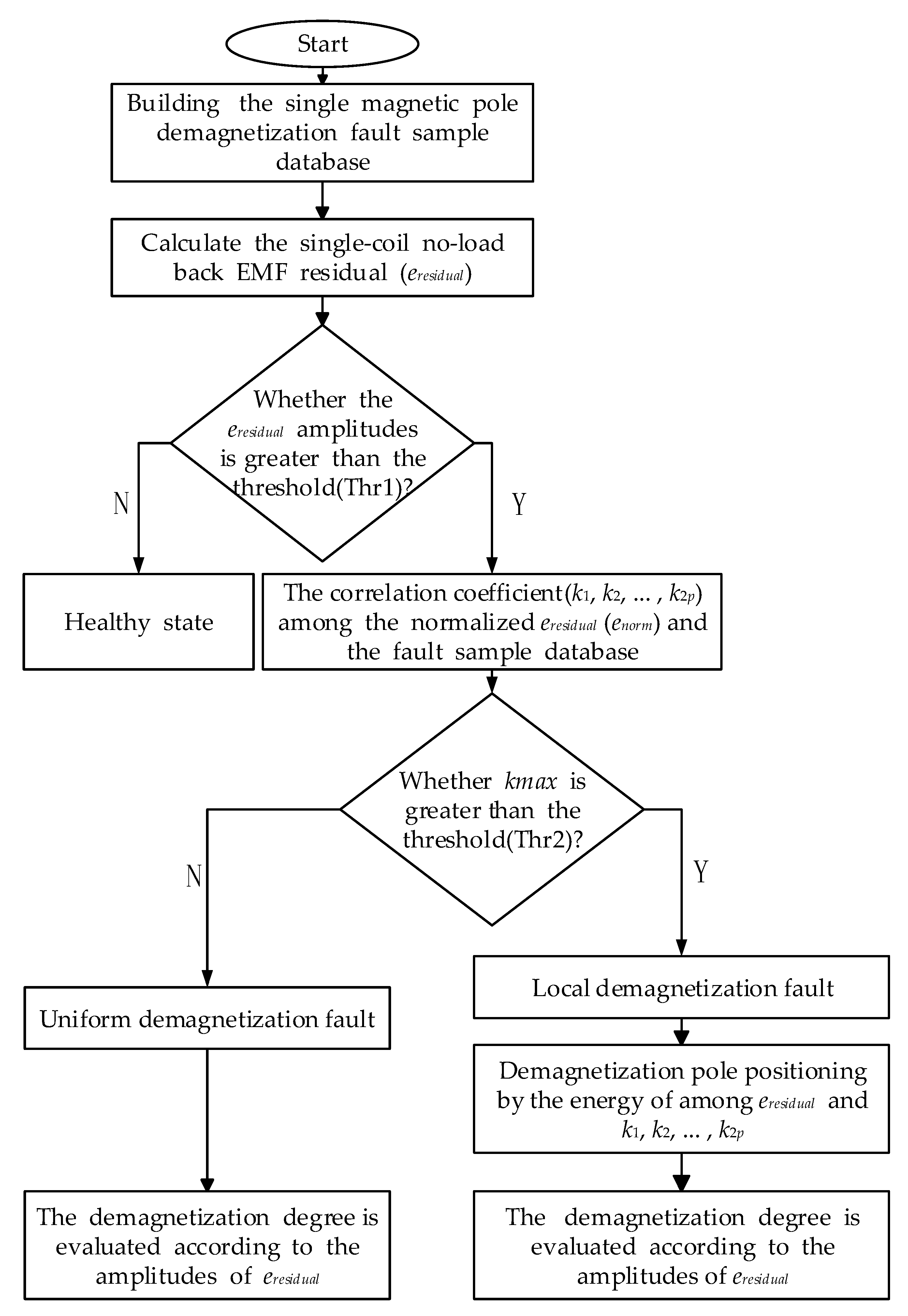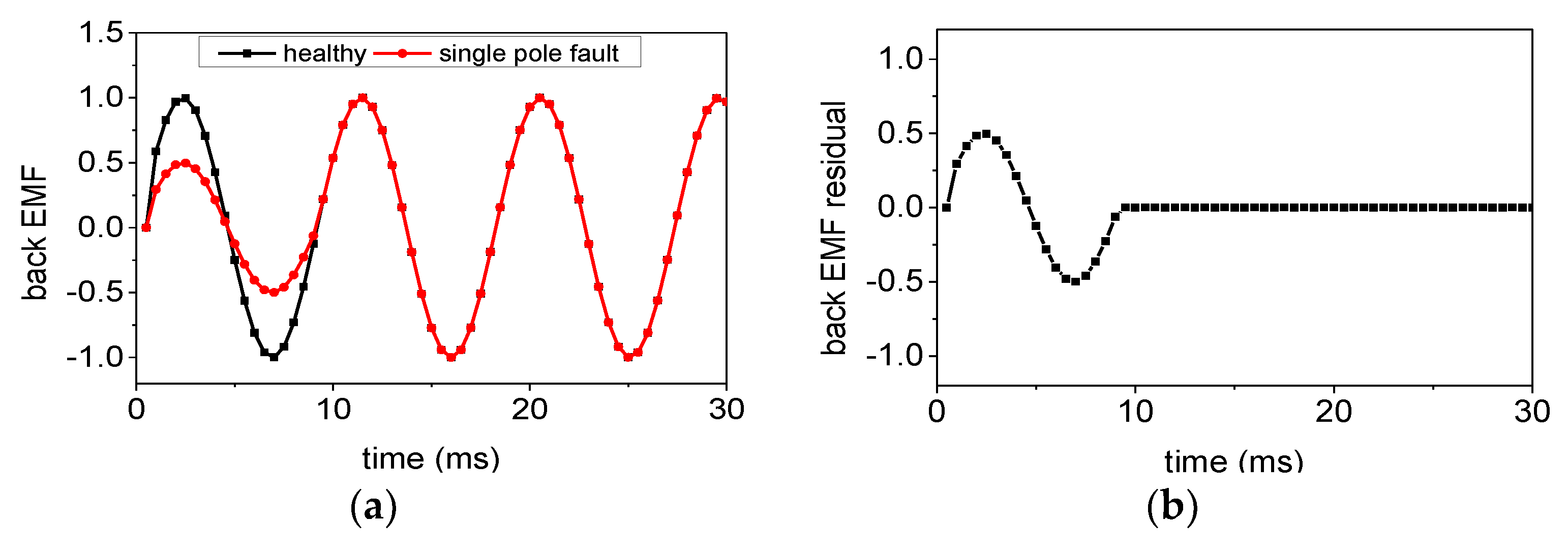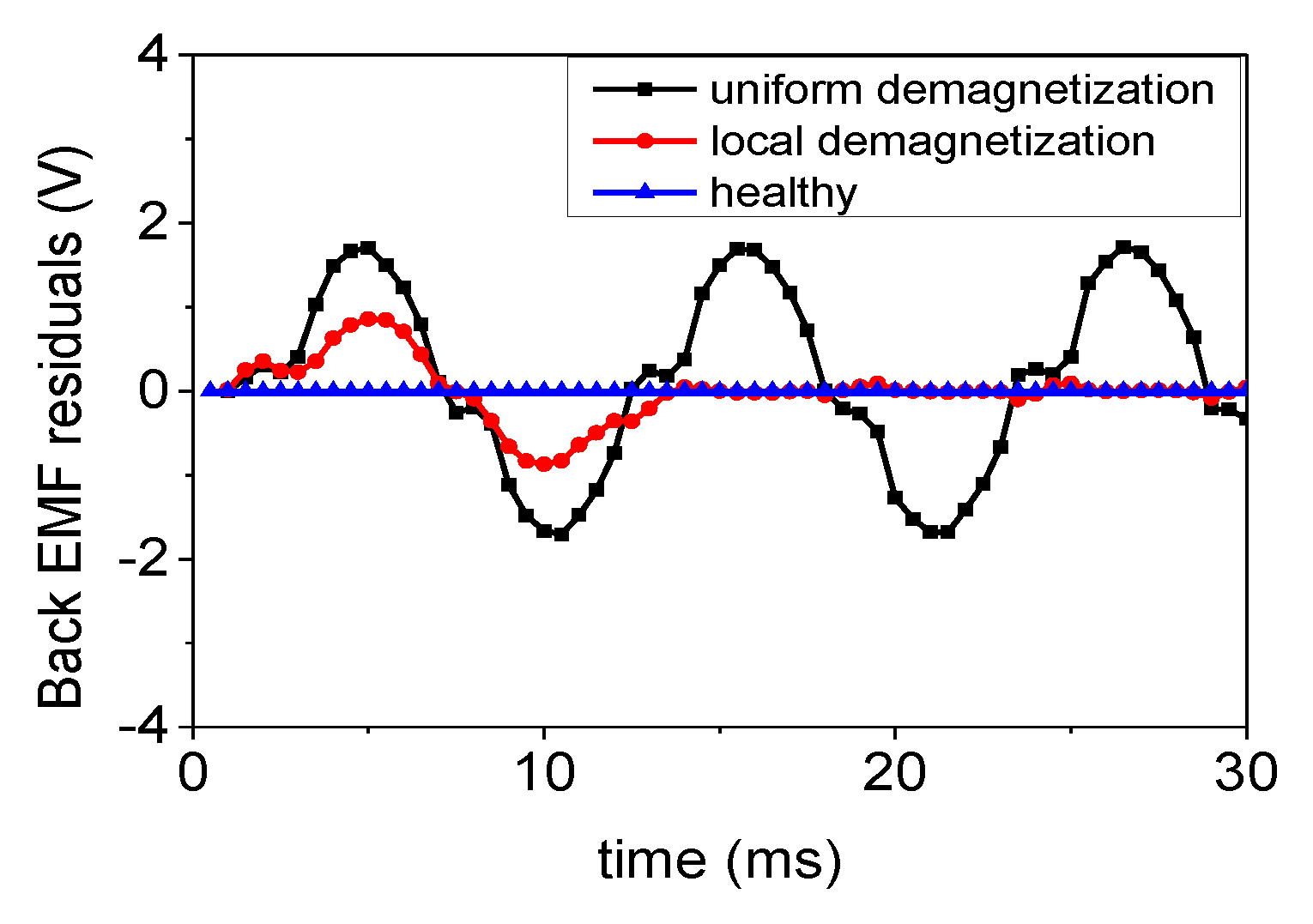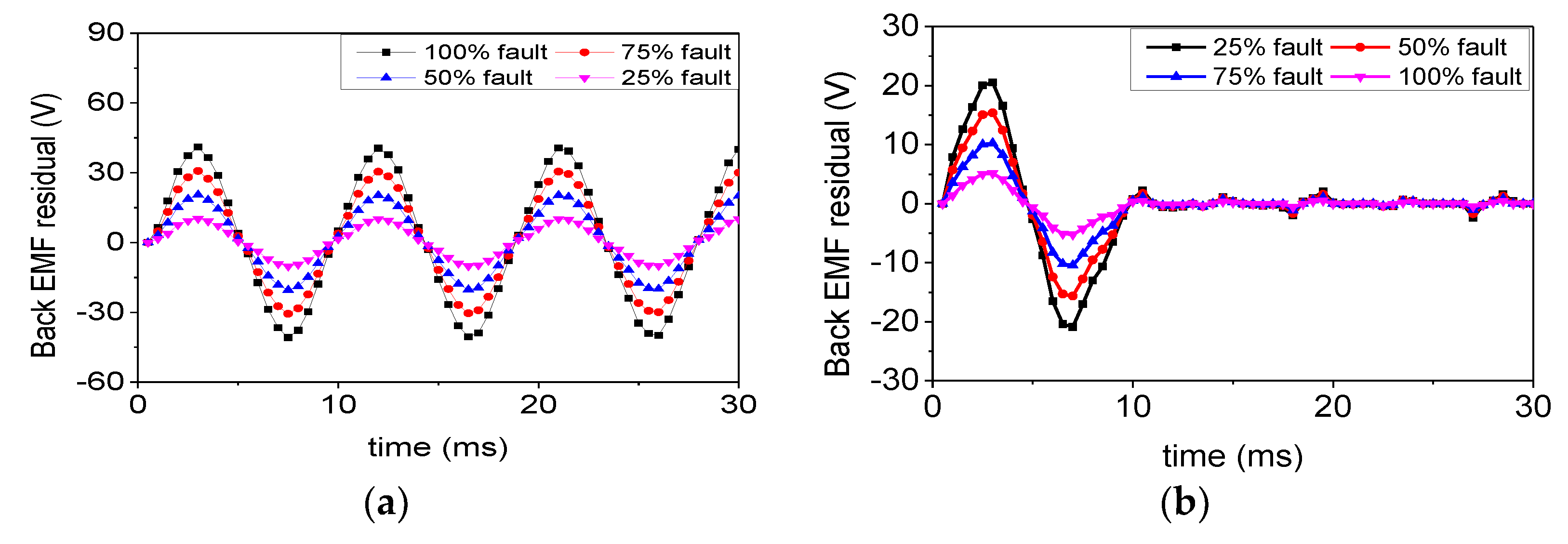Mode Recognition and Fault Positioning of Permanent Magnet Demagnetization for PMSM
Abstract
:1. Introduction
2. Structure and Parameters of PMSM
3. The Analytical Model of Single-Coil No-Load Back EMF of PMSM Demagnetization Fault
3.1. The Analytical Model of Single-Coil No-Load Back EMF
3.2. The Comparison of Simulation Results Between the Analytical Model and the FEM
4. The Methods of Demagnetization Fault Detection, Mode Recognition, Magnetic Pole Positioning, and Degree Evaluation
4.1. The Method of Demagnetization Fault Diagnosis
4.2. Establishment of Demagnetization Fault Sample Database
4.3. The Demagnetization Fault Detection and Mode Recognition
4.4. Fault Magnetic Pole Positioning
4.5. Demagnetization Fault Degree Evaluation
5. Analysis of FEM Simulation Results
5.1. Demagnetization Fault Detection and Mode Recognition
5.2. Fault Magnetic Pole Positioning
5.3. Demagnetization Fault Degree Evaluation
6. Conclusions
Author Contributions
Funding
Conflicts of Interest
References
- Boazz, B.; Pellegrino, G.; Vagati, A. Multipolar SPM machines for direct-drive application: A general design approach. IEEE. Trans. Ind. Appl. 2014, 50, 327–337. [Google Scholar] [CrossRef]
- Haddad, R.Z.S. Fault Detection and Identification in Permanent Magnet Synchronous Motors. Ph.D. Thesis, Michigan State University, East Lansing, MI, USA, 2016. [Google Scholar]
- Jawad, F.; Ehsan, M.-T. Demagnetization Modeling and Fault Diagnosing Techniques in Permanent Magnet Machines under Stationary and Nonstationary Conditions: An Overview. IEEE. Trans. Ind. Appl. 2017, 53, 2772–2785. [Google Scholar]
- LI, X.; Wang, S.H. Demagnetization analysis of the interior permanent magnet synchronous motor under different short circuit faults. J. China Coal Soc. 2017, 42, 626–632. [Google Scholar]
- Si, J.K.; Zheng, L.F.; Feng, H.C. Analysis of 3-D temperature field for surface-mounted and interior permanent magnet synchronous motor. Electr. Mach. Control 2017, 21, 25–31. [Google Scholar]
- Wang, C.; Prieto, M.D.; Romeral, L. Detection of Partial Demagnetization Fault in PMSMs Operating Under Nonstationary Conditions. IEEE. Trans. Magn. 2016, 52, 8105804. [Google Scholar] [CrossRef]
- Li, H.M.; Chen, T. The Local Demagnetization Fault Diagnosis of PMSM Based on Fractal Dimension. Trans. China Electrotech. Soc. 2017, 32, 1–10. [Google Scholar]
- Kim, H.-K.; Kang, D.-H.; Hur, J. Fault detection of irreversible demagnetization based on space harmonics according to equivalent magnetizing distribution. IEEE Trans. Magn. 2015, 51, 8109304. [Google Scholar] [CrossRef]
- Nejadi-Koti, H.; Faiz, J.; Demerdash, N.A.O. Uniform Demagnetization Fault Diagnosis in Permanent Magnet Synchronous Motors by Means of Cogging Torque Analysis. In Proceedings of the 2017 IEEE International Electric Machines and Drives Conference (IEMDC), Miami, FL, USA, 21–24 May 2017; pp. 1–7. [Google Scholar]
- Zhu, M.; Hu, W.S.; Kar, N.C. Acoustic Noise-Based Uniform Permanent-Magnet Demagnetization Detection in SPMSM for High-Performance PMSM Drive. IEEE Trans. Transp. Electrif. 2018, 4, 1397–1405. [Google Scholar] [CrossRef]
- Zhu, M.; Hu, W.S.; Kar, N.C. Multi-Sensor Fusion-Based Permanent Magnet Demagnetization Detection in Permanent Magnet Synchronous Machines. IEEE Trans. Transp. Electrif. 2018, 54, 8110106. [Google Scholar] [CrossRef]
- Zhang, C.F.; Wu, G.P.; He, J. Fault-Tolerant Predictive Control for Demagnetization Faults in Permanent Magnet Synchronous Machine. Trans. China Electrotech. Soc. 2017, 32, 100–110. [Google Scholar]
- Zhang, C.F.; Zhang, M.Y.; Zhang, F.M. A cascade observer to detect demagnetization faults for PMSM. Electr. Mach. Control. 2017, 21, 45–54. [Google Scholar]
- Hong, J.; Hyun, D.; Lee, S.B. Automated monitoring of magnet synchronous motors at standstill. IEEE. Trans. Ind. Appl. 2010, 46, 1397–1405. [Google Scholar] [CrossRef]
- Hong, J.; Hyun, D.; Kang, T.-J. Detection and classification of rotor demagnetization and eccentricity faults for PM Synchronous Motors. IEEE. Trans. Ind. Appl. 2012, 48, 923–931. [Google Scholar] [CrossRef]
- Da, Y.; Shi, X.D. A New Approach to Fault Diagnostics for Permanent Magnet Synchronous Machines Using Electromagnetic Signature Analysis. IEEE. Trans. Power Electron. 2013, 28, 4014–4112. [Google Scholar] [CrossRef]
- Li, H.M.; Chen, T. Demagnetization Fault Diagnosis and Fault Mode Recognition of PMSM for EV. Trans. China Electrotech. Soc. 2017, 32, 1–8. [Google Scholar]
- Li, W.L.; Cheng, P.; Wu, Z.X. Calculation and Analysis on the Permanent Magnet Partial Demagnetization Characteristics of the Grid-connected Permanent Magnet Synchronous Generator Rotor. Proc. CSEE 2013, 33, 96–103. [Google Scholar]
- Zhng, D.; Zhao, J.W.; Dong, F. Partial Demagnetization Fault Diagnosis Research of Permanent Magnet Synchronous Motor Based on PNN Algorithm. Proc. CSEE. 2019, 39, 296–306. [Google Scholar]
- Urresty, J.-C.; Riba, J.-R.; Delgado, M. Detection of Demagnetization Faults in Surface-Mounted Permanent Magnet Synchronous Motors by Means of the Zero-Sequence Voltage Component. IEEE Trans. Energy Convers. 2012, 27, 42–51. [Google Scholar] [CrossRef]










| Items | Values | Unit |
|---|---|---|
| Out diameter of stator | 360 | mm |
| Inner diameter of stator | 300 | mm |
| Air-gap length | 1.2 | mm |
| Wire diameter of winding | 1.3 | mm |
| Area of slot | 154 | mm2 |
| Thickness of PM | 5.3 | mm |
| Angle of PM | 5 | ° |
| Axial length | 150 | mm |
| Rated power | 10 | kW |
| Rated speed | 200 | r/min |
| Number of phases | 3 | - |
| Number of coils | 36 | |
| Coil turn | 48 | |
| Parallel-circuits per phase | 3 | |
| Slot-Pole combination | 72–66 |
| Sample Characteristic Quantity Numbered | Uniform Demagnetization Fault Degree | |
|---|---|---|
| Fault 25% | Fault 75% | |
| 1 | 0.1748 | 0.1747 |
| 2 | 0.1749 | 0.1749 |
| 3 | 0.1749 | 0.1748 |
| 4 | 0.1746 | 0.1746 |
| 5 | 0.1749 | 0.1745 |
| 6 | 0.1741 | 0.1743 |
| 7 | 0.1740 | 0.1746 |
| 8 | 0.1742 | 0.1741 |
| … | … | … |
| 2p | 0.1747 | 0.1746 |
| Sample Characteristic Quantity Numbered | Local Demagnetization Fault Degree | |
|---|---|---|
| Fault 25% | Fault 75% | |
| 1 | 0.5 | 0.5 |
| 2 | 1 | 1 |
| 3 | 0.5 | 0.5 |
| 4 | −2.1972 × 10−8 | -2.1982 × 10−8 |
| 5 | 9.9593 × 10−11 | 9.9571 × 10−11 |
| 6 | 1.1050 × 10−10 | 1.1140 × 10−10 |
| 7 | 1.1051 × 10−10 | 1.1041 × 10−10 |
| 8 | 9.8452 × 10−11 | 9.8471 × 10−11 |
| … | … | … |
| 2p | 1.1131 × 10−10 | 1.1067 × 10−10 |
| Sample Characteristic Quantity Numbered | Uniform Demagnetization Fault Degree | |||
|---|---|---|---|---|
| Fault 12.5% | Fault 25% | Fault 50% | Fault 75% | |
| 1 | 0.1952 | 0.1952 | 0.1952 | 0.1952 |
| 2 | 0.1952 | 0.1952 | 0.1952 | 0.1952 |
| 3 | 0.1954 | 0.1954 | 0.1954 | 0.1954 |
| 4 | 0.1951 | 0.1951 | 0.1951 | 0.1951 |
| 5 | 0.1951 | 0.1951 | 0.1951 | 0.1951 |
| 6 | 0.1954 | 0.1954 | 0.1954 | 0.1954 |
| Sample Characteristic Quantity Numbered | Local Demagnetization Fault Degree | |||
|---|---|---|---|---|
| Fault 12.5% | Fault 25% | Fault 50% | Fault 75% | |
| 1 | 0.4413 | 0.4492 | 0.4566 | 0.4613 |
| 2 | 0.9924 | 0.9958 | 0.9984 | 0.9996 |
| 3 | 0.4446 | 0.4474 | 0.4522 | 0.4567 |
| 4 | 0.0166 | 0.0187 | 0.0243 | 0.0289 |
| 5 | 0.0019 | 0.0005 | 0.0057 | 0.0104 |
| 6 | 0.0285 | 0.0299 | 0.0337 | 0.0375 |
| One Pole Fault | Two Pole Fault | Three Pole Fault | |||
|---|---|---|---|---|---|
| Fault Pole | Energy | Fault Pole | Energy | Fault Pole | Energy |
| 1 | 697 | 1, 2 | 1990 | 1, 2, 3 | 3276 |
| 2 | 699 | 1, 3 | 1433 | 1, 2, 4 | 2711 |
| 3 | 703 | 1, 4 | 1406 | 1, 3, 4 | 2700 |
| 4 | 699 | 1, 5 | 1458 | 1, 2, 5 | 2687 |
| 5 | 703 | 1, 6 | 1407 | 1, 3, 5 | 2273 |
| 6 | 699 | 2, 3 | 1995 | 2, 3, 4 | 3280 |
| Sample Characteristic Quantity Numbered | Demagnetization Magnetic Pole Numbered | |||||||||||
|---|---|---|---|---|---|---|---|---|---|---|---|---|
| One Pole Fault | Two Pole Fault | Three Pole Fault | ||||||||||
| 1 | 2 | 3 | 4 | 5 | 6 | 1, 2 | 1, 3 | 2, 3 | 1, 2, 3 | 1, 2, 4 | 1, 3, 5 | |
| 1 | 0.9924 | 0.4651 | 0.0308 | 0.0170 | 0.0384 | 0.0130 | 0.8519 | 0.7215 | 0.2749 | 0.6735 | 0.7410 | 0.6023 |
| 2 | 0.4651 | 0.9958 | 0.4638 | 0.0335 | 0.0152 | 0.0415 | 0.8525 | 0.6333 | 0.8471 | 0.8684 | 0.7504 | 0.5113 |
| 3 | 0.0308 | 0.4638 | 0.9901 | 0.4661 | 0.0300 | 0.0178 | 0.2721 | 0.7052 | 0.8564 | 0.6702 | 0.4709 | 0.5684 |
| 4 | 0.0170 | 0.0335 | 0.4661 | 0.9988 | 0.4632 | 0.0338 | 0.0037 | 0.3536 | 0.2737 | 0.2176 | 0.5095 | 0.5136 |
| 5 | 0.0384 | 0.0152 | 0.0300 | 0.4632 | 0.9996 | 0.4641 | 0.0126 | 0.0743 | 0.0018 | 0.0218 | 0.2461 | 0.5837 |
| 6 | 0.0130 | 0.0415 | 0.0178 | 0.0338 | 0.4641 | 0.9927 | 0.0107 | 0.0425 | 0.0137 | 0.0157 | 0.0264 | 0.3128 |
| FEM Simulation Value | 0 | 25% | 50% | 75% | 100% |
|---|---|---|---|---|---|
| evaluation value | 0 | 25.01% | 50.00% | 74.99% | 100% |
| FEM Simulation Value | 0 | 25% | 50% | 75% | 100% |
|---|---|---|---|---|---|
| evaluation value | 0 | 25.02% | 50.03% | 74.97% | 100% |
© 2019 by the authors. Licensee MDPI, Basel, Switzerland. This article is an open access article distributed under the terms and conditions of the Creative Commons Attribution (CC BY) license (http://creativecommons.org/licenses/by/4.0/).
Share and Cite
Gao, C.; Nie, Y.; Si, J.; Fu, Z.; Feng, H. Mode Recognition and Fault Positioning of Permanent Magnet Demagnetization for PMSM. Energies 2019, 12, 1644. https://doi.org/10.3390/en12091644
Gao C, Nie Y, Si J, Fu Z, Feng H. Mode Recognition and Fault Positioning of Permanent Magnet Demagnetization for PMSM. Energies. 2019; 12(9):1644. https://doi.org/10.3390/en12091644
Chicago/Turabian StyleGao, Caixia, Yanjie Nie, Jikai Si, Ziyi Fu, and Haichao Feng. 2019. "Mode Recognition and Fault Positioning of Permanent Magnet Demagnetization for PMSM" Energies 12, no. 9: 1644. https://doi.org/10.3390/en12091644





